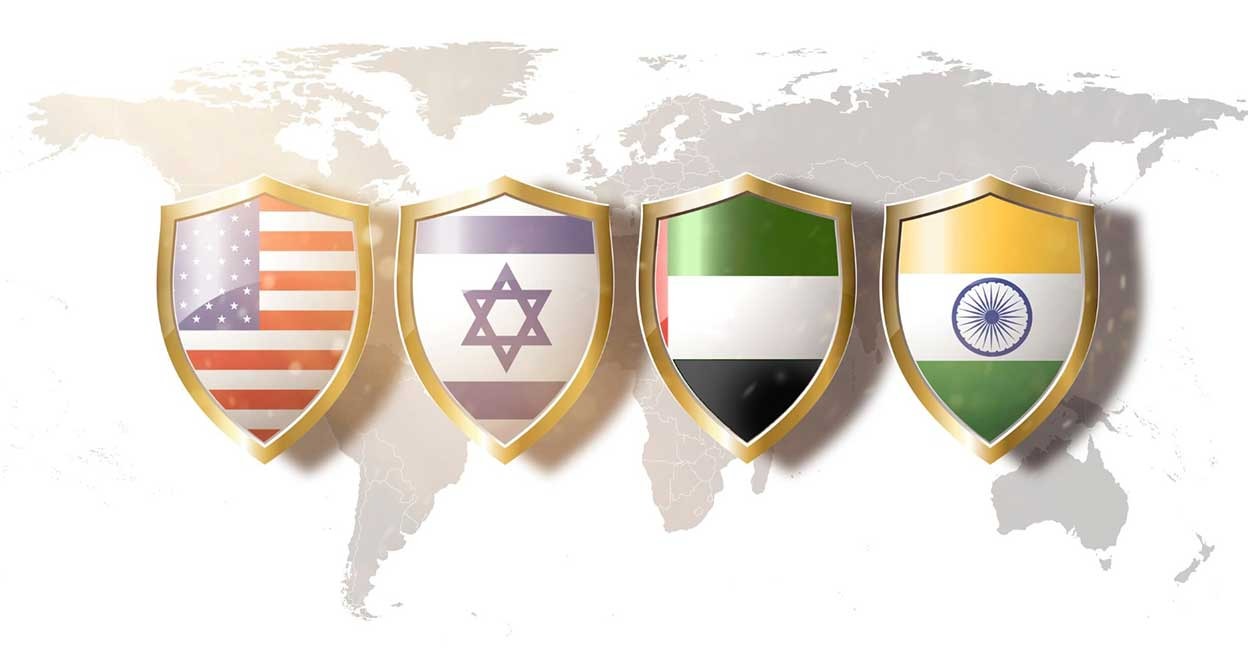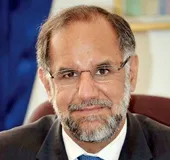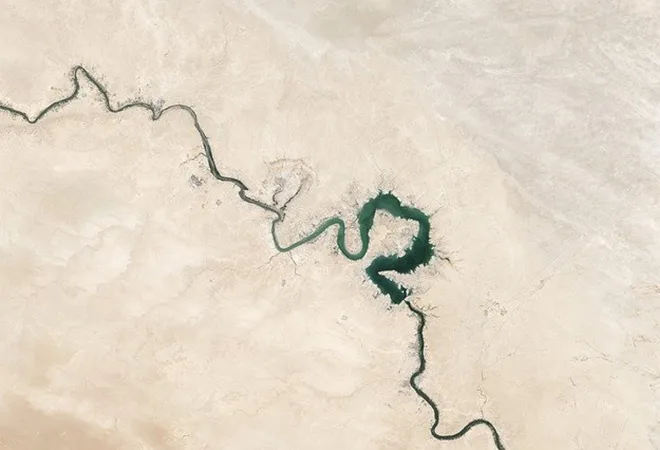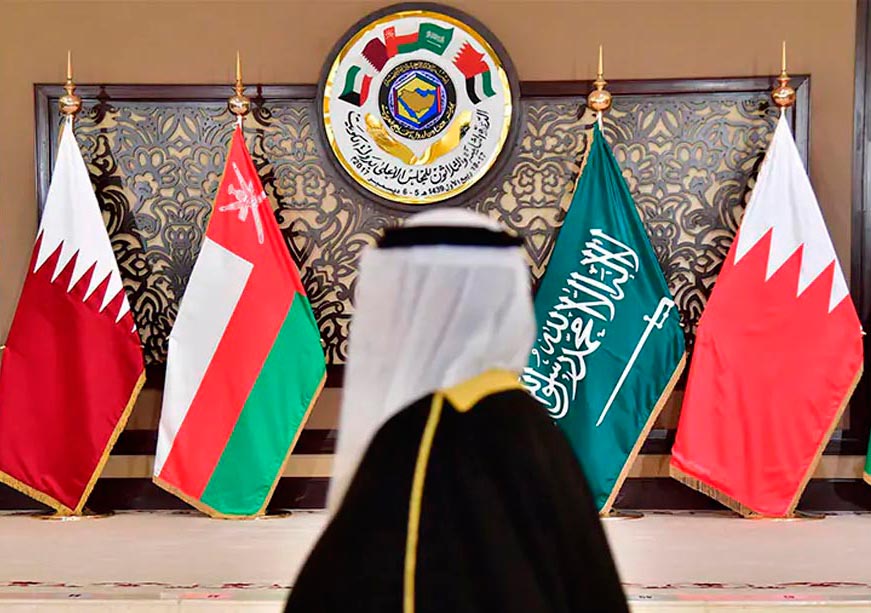Minilateral organisations have increased in number in recent years, reflecting a new paradigm in international relations. The I2U2 (India, Israel, United States and UAE), launched in July this year, is one such minilateral. With its priorities set on a geoeconomic agenda, the I2U2 is being driven by both, the member countries’ own motivations and their shared interests. This brief gives an overview of the grouping and its objectives. It highlights two key projects, explores potential challenges, and underscores the benefits that India stands to gain from its participation in the grouping.
Attribution: Navdeep Suri and Hargun Sethi, “The I2U2: Where Geography and Economics Meet,” ORF Issue Brief No. 618, February 2023, Observer Research Foundation.
Introduction
In July 2022, India, Israel, the United States (US), and the United Arab Emirates (UAE) in a hybrid summit announced the establishment of a new minilateral grouping called the I2U2. The four countries envision their alliance as an ad-hoc, informal, issue-specific and geoeconomic initiative.[1]
The I2U2 is only one of a number of minilateral forums that have been created in the past several years. Unburdened by the complexities of decision-making and institutional constraints of larger organisations, “minilaterals (which often involve three to nine countries) offer an edge vis-à-vis flexibility, informality, select membership, and a goal-oriented focus.”[2] This shift towards multi-alignment is driven by the growing importance of geoeconomics, which is shaping the way countries collaborate and form partnerships to advance their economic interests. By focusing on shared economic interests, member countries are able to build trust, overcome political differences, and develop an expansive agenda for cooperation that integrates geopolitics and geoeconomics. Acknowledging the practicality of this paradigm shift, the joint statement of the I2U2 countries, released following the July summit, said the “grouping is intended to mobilise private sector capital and expertise to modernise infrastructure, advance low carbon development pathways for industries, improve public health and access to vaccines, advance physical connectivity, create new solutions for waste treatment, explore joint financing opportunities, and lastly, promote the development of critical emerging and green technologies, while focussing on food and energy security.”[3]
To be sure, all four countries have their own motivations for joining the grouping. For India, the I2U2 provides a forum to bolster its renewed strategic engagement with West Asia. India also has a robust bilateral relationship with each of the three countries and thus there is a strong economic rationale for its participation in I2U2. India’s total trade with UAE amounted to US$ 73 billion in 2022, making UAE India’s third largest trading partner.[4] UAE is also India’s second largest export destination and accounts for 40 percent of India’s total trade with the Arab world. Israel, meanwhile, is one of India’s top suppliers of defence equipment and a key technology partner in different domains including defence, space, agriculture, and cybersecurity.[5] For its part, the US is India’s largest trading partner and second-largest foreign investor, with bilateral trade reaching US$ 119 billion in 2022 and investments accounting for 18 percent of total Foreign Direct Investment.[6]
From Israel’s perspective, I2U2 is a continuation of the Abraham Accords and presents a new opportunity to build a platform where it can combine its old partners (the US and India) with the new (UAE) through a wider economic and strategic partnership. The Accords formalised ties between Israel and the UAE,[7] while also enabling Israel to extend its outreach into the Arab world and beyond. This aligns with Israel’s larger goal of encouraging more countries in the region to normalise relations with it.
The Emiratis view I2U2 as a coalition that is agile and purposeful. They are of the view that such a grouping, with a focus on complementarities, will help solve global challenges such as those related to security in food, energy, and water. The UAE knows these challenges only too well, given its own food and water shortages, with an annual rainfall of only 100mm and importing 85 percent of its food supplies.[8] UAE also sees I2U2 as a platform that can serve its interests in strengthening bilateral ties with the other three nations, while placing itself as the bridge between West Asia and South Asia.
For the United States, the grouping is a low-hanging fruit, following the Abraham Accords, through which it can nurture relationships with its allies and partners bilaterally as well as multilaterally, especially in the West Asian region. This also helps the US in checking the expanding Chinese footprint in the region, particularly in the fields of investment, innovation, and technology. US participation also indicates that it has shed its traditional strategic and security lens and now views the world order in a trans-regional and multilateral way.
Setting the Context
I2U2’s seeds were sown in October 2021, when the foreign ministers of the four countries held a virtual meeting to address issues concerning maritime security, infrastructure, and transport.[9] Its launch in July reflects some of the broader changes that have recently taken place in global geopolitics, especially in West Asia.
The first crucial development was the establishment of Israel’s diplomatic ties with UAE and Bahrain in August 2020 through the signing of the Abraham Accords orchestrated by the Trump administration. Relations with UAE have grown since then, at a pace that has surprised observers. Their bilateral trade (excluding software) reached US$ 2.5 billion in 2022.[10] As the Accords opened room for increased interactions between Israel and its Gulf neighbours, it has become less difficult for other partners like the US and India to engage with the region through plurilateral forums.[11]
The outbreak of the Russia-Ukraine war in early 2022, along with the impacts of the COVID-19 pandemic, are pointing to a new era where realist considerations of shared threats push geographically divergent countries to come together and find solutions to pressing global challenges. Among the most crucial are global economic deceleration, increasing debt, supply chain break-downs, trade wars, energy insecurity, food crises, widening inequalities, large-scale poverty, and worsening climate change.[12]
The 2022 World Development Report, Finance for an Equitable Recovery has highlighted how the growing disparities between and within nations, along with slower than expected post-pandemic global recovery has “made the economic and social costs of dwindling growth more visible.”[13] This strengthens the rationale for the I2U2 to gather and manage the current multiple crises facing the region and beyond.
The I2U2 countries intend to give primacy to their economic strengths over their differing political and security concerns, and utilise the available opportunities for mutually beneficial cooperation. They will leverage “India with its growing economy, and massive human resource and talent, Israel with its niche technical know-how in a number of important fields, UAE with its vast capital and advancing innovative policies, and USA’s extensive international clout and capabilities in every conceivable area.”[14]
Since the establishment of I2U2, several meetings have taken place between officials and private sector representatives from the four countries. One of the areas that have been explored in the discussions is shoring up business-to-business (B2B) relations. During the February 2023 meeting of the four sherpas, an I2U2 Business Forum was established to accelerate joint business ventures in core economic and technological sectors.[15] There is also a proposal among private sector entities to form an enterprise called the ‘I2U2 Hub’ in UAE, which will serve as an ideation centre. It aims to utilise the network of its business members in forging economic partnerships with companies and institutions involved in research in any of the six identified sectors, with an incentive of sharing profits of intellectual property amongst the partnering institutions.
Key Projects
Distinguishing it from other regional forums like the Quadrilateral Security Dialogue (Quad), Negev Forum, and AUKUS, I2U2 initially aims to focus on an economic agenda. It has identified six sectors for intervention—i.e., water, energy, transportation, space, health, and food security. The grouping envisions an active role for private capital and technology, declaring a strong commitment “to collaborate on propelling joint investments, resource mobilisation and new initiatives for seeking optimal mitigation strategy.”[16] Underscoring the practical nature of the discussions and initiatives undertaken, Prime Minister Narendra Modi in his remarks at the summit said the I2U2 “has set a positive agenda and its framework is a good model for practical cooperation in the face of increasing global uncertainties.”[17]
Two key global concerns are being prioritised by the grouping—food security and clean energy—which have local, trans-regional and long-term dimensions.
Food corridor project
Some 820 million people across the globe are suffering from hunger[18] and many regions are facing a looming food crisis. The I2U2’s food security project aims to address food insecurity by capitalising on the member countries’ comparative advantages across financial, technological, agricultural and knowledge domains.
The project will use Israeli and American technology to establish integrated food parks in the states of Gujarat and Madhya Pradesh, with future expansion planned for other states, including Telangana, Andhra Pradesh, and Maharashtra. The project is being financed by the Abu Dhabi Development Holding Company (ADQ)— an active sovereign wealth fund that has committed an overall investment worth US$2 billion.[19] The broader objective of the initiative is to create alternate supply chains among countries with similar goals, to guarantee food security that is environmentally sustainable.
The project will be driven through a comprehensive public-private partnership model, involving the concerned state governments, the central government, and the private sector spearheaded by the Confederation of Indian Industry (CII). Some of the private firms that have been selected for developing the value chains include ITC, Innoterra and Olam. DP World has been designated as the logistics partner for operationalising the food corridor through development of eco-friendly integrated logistics services like container terminals at seaports, private rail rakes, regional procurement centres, and warehousing and refrigeration facilities.
Analysts note that the project will not only help the Gulf countries achieve food security, but also “enable India to increase the value of its food production by taking advantage of advanced investments and technology that will enter its agriculture sector.”[20] This, in turn, will help enhance Indian farmers’ incomes and support job creation through development of post-harvest activities. Being a food-surplus nation and a large producer of wheat, dairy, vegetables and fruits, India has a lot to offer, and gain from this project. Highlighting its significance, Indian Foreign Secretary Vinay Mohan Kwatra explained that “the proposed food parks have a set of objectives that include how to reduce trade barriers between I2U2 economies, how to harmonise food quality and safety standards, and how to use this opportunity to benchmark India as a top exporter of perishables through access to strategic markets of the Gulf and European region.”[21]
Hybrid renewable energy project
To reduce the use of fossil fuels and increase the share of renewables in energy production as agreed at COP27,[22] the second I2U2 project will establish a 300-megawatt hybrid renewable energy facility (wind and solar) in Gujarat. The facility will be complemented by an advanced battery storage technology that will be developed with the help of Israeli expertise, and Emirati and American investments. It aims to bring down battery storage costs and make renewable energy an attractive option for the industrial sector. The project is currently valued at US$330 million, and the financing will be done through public-private partnership.
UAE-based companies like Masdar have shown strong interest in “exploring opportunities to serve as critical knowledge and investment partners in the renewable energy space,”[23] particularly in the context of UAE’s position as host of COP28 scheduled in December 2023. For India, its reliance on coal—which generates 70 percent of its electricity—and the limitations in importing Liquefied Natural Gas, has motivated the country to diversify its energy mix. This has incentivised Indian companies to participate in renewable energy projects to contribute to the country’s goal of achieving 500 gigawatts of non-fossil fuel capacity by 2030.[24] A feasibility study on the project, funded by the US Trade and Development Agency (USTDA), has already given a green light to the project.
Potential Challenges
The first potential challenge for the I2U2 is that individual countries may give primacy to their own security interests, which may be in contrast to those of another. For example, “Iranian rivalry is central to the US and Israeli outlook of West Asia,”[25] while India and UAE might have a different perspective. Although the four countries have so far been able to keep these security considerations at bay, the situation with regard to Iran remains unpredictable.
Meanwhile, the US and India are wary of China’s footprint in the region, which the latter is expanding through trade deals, infrastructure investments and security cooperation. Israel and UAE, for their part, have a more positive view of China, with UAE upgrading its ties to a Comprehensive Strategic Partnership[26] and Israel engaging China in defence and technical cooperation.[27]
A second set of concerns are related to institutional bottlenecks. There could be lack of synergy in the working cultures of business people from the four countries, and accountability mechanisms may be vague. The sherpas of the respective countries should acknowledge these potential roadblocks and streamline processes to enforce checks and balances.
India’s Stakes
India’s position as the glue that binds West Asia with South Asia makes its active participation in the grouping of utmost importance. At the same time, India can leverage investments, innovation and technology from I2U2 to accelerate its own journey towards becoming the world’s third largest economy in the coming decade. I2U2 can also be a force-multiplier for the ‘Make in India’ initiative by pushing for manufacturing facilities to be set up in the country, particularly in the fields of artificial intelligence, fintech, transportation, and space.
To ensure fruitful cooperation with the other three countries, India could take a cue from the US and designate I2U2 nodal officers in each of its embassies in the three countries. The sherpa, along with these nodal officers, can form a Coordinating Committee that will help streamline official communication and monitor progress. The I2U2 grouping could potentially become a catalyst for India to spearhead similar minilateral groupings with its other partners in South Asia and Africa.
Conclusion
The four member nations of I2U2 should create a consolidated roadmap to bring their plans to fruition. There is a need to institutionalise a system of regular meetings between the foreign ministers and an annual summit of the leaders to keep the grouping active and ensure timely implementation of decisions. The member countries can devise an institutional framework with dedicated resources, professionals, and clear goals. For this, like the G20, it can establish joint Task Forces on specific sectors with participation from government, academia, think tanks, and the private sector. These task forces can act as both, ‘idea banks’ and implementing agencies. Additionally, Centres of Excellence can be established across geographies of the four countries focusing on specific sectors like cybersecurity, healthcare, and outer space. Lastly, the four countries would need to institute legislations pertaining to taxation, customs, and arbitration to facilitate project implementation.
As an alternative to the dismal performance of most multilateral institutions, minilaterals like I2U2 provide hope for more effective and mutually beneficial international cooperation. Keeping in mind the global nature of challenges faced by countries across the world, a platform like the I2U2 can provide a sound framework to explore opportunities, support collective resolution of global challenges, and unlock avenues for greater convergence of interests and actions between countries.
Navdeep Suri is Distinguished Fellow at ORF.
Hargun Sethi was a Research Intern at ORF.
Endnotes
[1] “Partnerships and economy are best way to overcome today’s complex challenges: UAE President at I2U2 Leaders’ Summit,” WAM- The Emirates News Agency, July 14, 2022.
[2] Amalina Anuar and Nazia Hussain, “Minilateralism for Multilateralism in the Post-COVID Age,” Nanyang Technological University Policy Report, January 2021.
[3] The White House, “Joint Statement of the Leaders of India, Israel, the United Arab Emirates, and the United States (I2U2),” 2022.
[4] Embassy of India, Abu Dhabi, UAE, “Bilateral Economic and Commercial Relations,” November 2022, https://indembassyuae.gov.in/bilateral-eco-com-relation.php
[5] Navdeep Suri and Hargun Sethi, “30 years of bilateral ties: What Indo-Israeli relations look like,” Observer Research Foundation, September 12, 2022.
[6] Shishir Gupta, “India reported highest FDI inflow worth $83 billion in 2021-22: Centre,” Hindustan Times, May 20, 2022.
[7] Navdeep Suri and Hargun Sethi, “Growing UAE-Israel ties shows political intent to deepen relations between the two countries,” Observer Research Foundation, October 22, 2022.
[8] Omnia Al Desoukie, “The UAE’s new food strategy: reducing imports and investing in agtech,” Food Matters Live, September 14, 2021.
[9] “I2U2- New Formations for better Growth,” Centre of Policy Research and Governance, July 20, 2022.
[10] “UAE-Israel trade hits record high to reach $2.56bn n 2022,” Arab News, January 23, 2023.
[11] Niranjan Marjani, “Contextualizing the I2U2 for India,” Times of India, July 13, 2022.
[12] Ishani Agnihotri, “I2U2: The Aspects and the Prospects,” Indian Council of World Affairs, August 16, 2022.
[13] World Bank, World Development Report 2022: Finance for an Equitable Recovery.
[14] Daniel Markey, “What You Need to Know About the I2U2,” United States Institute of Peace, July 28, 2022.
[15] Muhammad Aamir, “Inaugural I2U2 Business Forum convened to accelerate joint investments in key sectors,” WAM- The Emirates News Agency, February 22, 2023.
[16] Debasis Bhattacharya, “I2U2 Grouping: Transformational Force for Global Good and India’s Strategic Imperatives,” Vivekananda International Foundation, August 9, 2022.
[17] “I2U2 has set positive agenda, good model for practical cooperation: PM Modi,” Indian Express, July 15, 2022.
[18] “UN Report: Global hunger numbers rose to as many as 828 million in 2021,” Food and Agriculture Organization of the United Nations, June 6, 2022.
[19] Sachin Parashar, “UAE’s $2 billion and US, Israel tech for India food parks,” The Times of India, July 15, 2022.
[20] Nerea Belmonte, “The India-Arab Emirates-Israel route, an alternative for global food security,” Atalayar, August 4, 2022.
[21] “I2U2 summit unveils USD 2 billion initiative to develop food parks across India,” The Print, July 15, 2022.
[22] “COP27: Causes and Effects of Climate Change,” SGS, November 3, 2022.
[23] “I2U2 Summit: UAE to invest $2bn in food parks in Gujarat, MP, to boost food security,” United News of India, July 14, 2022.
[24] Prime Minister’s Office, Government of India.
[25] Agnihotri, “I2U2: The Aspects and the Prospects”
[26] Mohamed Bin Huwaidin, “China’s strategic partnership with the UAE: Foundation and prospects, Comparative Strategy,” Comparative Strategy, April 15, 2022.
[27] “Israel-China Relations in an Era of Strategic Rivalry and Great Power Competition,” Strategic Assessment, July 2022.












